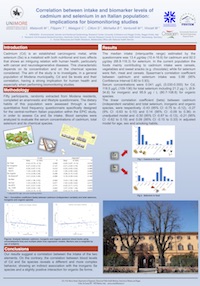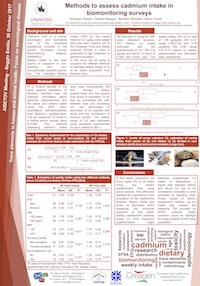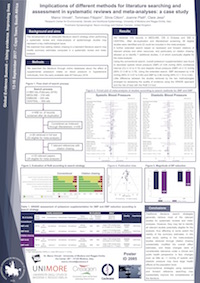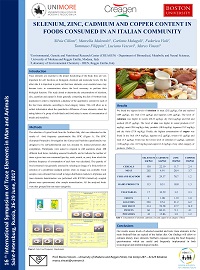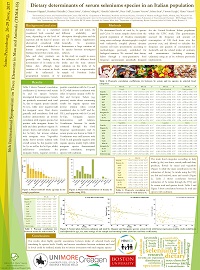Cadmium (Cd) is an established carcinogenic metal, while selenium (Se) is a metalloid with both nutritional and toxic effects that shows an intriguing relation with human health, particularly with cancer and neurodegenerative diseases. This characteristic depends on its concentration and on the chemical species considered. The aim of the study is to investigate, in a general population of Modena municipality, Cd and Se levels and their correlation, having a strong implication for human health and especially when performing biomonitoring studies.
Poster: Comparative methods to estimate of cadmium intake in an Italian population
Cadmium (Cd) is a human toxic and carcinogens which represents one of the prioritized substances included in the current European Human Biomonitoring (HMBI4EU). Chronic Cd exposure is generally lead to kidney and bone disease, but recent findings have point out such association between Cd exposure with cardio-cerebrovascular risk factors, including glucose intolerance, diabetes and atherosclerosis. Diet is the main source of exposure in non-smoking and non-occupationally exposed subjects. The Tolerable Weekly Intake (TWI) for this heavy metal of 2.5 μg/kg body weight (bw) has been recently set by the European Food and Safety Authority (EFSA) in order to guarantee a high protection to general population. In this study we are going to compare two different methods to estimate weekly intake of Cd.
Original article: The Epidemiology of Selenium and Human Cancer
Vinceti M, Filippini T, Cilloni S, Crespi CM.
Adv Cancer Res. 2017;136:1-48. doi: 10.1016/bs.acr.2017.07.001
Abstract
The relation between selenium and cancer has been one of the most hotly debated topics in human health over the last decades. Early…
Poster: Implications of different methods for literature searching and assessment in systematic reviews and meta-analyses: a case study
The development of an adequate literature search strategy when performing a systematic review and meta-analysis of epidemiologic studies may represent a key methodological issue.
Objective
We explored how adding citation chasing to a standard literature search may modify summary estimates computed in a systematic review and meta-analysis.
Original article: Pesticide exposure assessed through agricultural crop proximity and risk of amyotrophic lateral sclerosis
Vinceti M, Filippini T, Violi F, Rothman KJ, Costanzini S, Malagoli C, Wise LA, Odone A, Signorelli C, Iacuzio L, Arcolin E, Mandrioli J, Fini N, Patti F, Lo Fermo S, Pietrini V, Teggi S, Ghermandi G, Scillieri R, Ledda C, Mauceri C, Sciacca S, Fiore M, Ferrante M.
Environ Health. 2017 Aug 29;16(1):91. doi: 10.1186/s12940-017-0297-2
Abstract
BACKGROUND: Epidemiologic studies have raised the possibility that some pesticide compounds induce the neurodegenerative disease amyotrophic lateral sclerosis (ALS), though the available evidence is not entirely consistent.
METHODS: We conducted a population-based case-control study in two Italian populations to assess the extent to which residence in the vicinity of agricultural crops associated with the application of neurotoxic pesticides is a risk factor for ALS, using crop acreage in proximity to the residence as an index of exposure.
RESULTS: Based on 703 cases and 2737 controls, we computed an ALS odds ratio of 0.92 (95% confidence interval 0.78-1.09) for those in proximity to agricultural land. Results were not substantially different when using alternative exposure categories or when analyzing specific crop types, with the exception of a higher risk related to exposure to citrus orchards and olive groves in Southern Italy, though based on few exposed subjects (N = 89 and 8, respectively). There was little evidence of any dose-response relation between crop proximity and ALS risk, and using long-term residence instead of current residence did not substantially change our estimates.
CONCLUSIONS: Though our index of exposure is indirect and subject to considerable misclassification, our results offer little support for the hypothesis that neurotoxic pesticide exposure increases ALS risk.
Original paper: A GIS-based atmospheric dispersion model for pollutants emitted by complex source areas
Teggi S, CostanziniS, Ghermandi G, Malagoli M, Vinceti M.
Sci Total Environ. 2017 Aug 10;610-611:175-190. doi: 10.1016/j.scitotenv.2017.07.196.
Abstract
Gaussian dispersion models are widely used to simulate the concentrations and deposition fluxes of pollutants emitted by source areas. Very often, the calculation time limits the number of sources and receptors and the geometry of the sources must be simple and without holes. This paper presents CAREA, a new GIS-based Gaussian model for complex source areas. CAREA was coded in the Python language, and is largely based on a simplified formulation of the very popular and recognized AERMOD model. The model allows users to define in a GIS environment thousands of gridded or scattered receptors and thousands of complex sources with hundreds of vertices and holes. CAREA computes ground level, or near ground level, concentrations and dry deposition fluxes of pollutants. The input/output and the runs of the model can be completely managed in GIS environment (e.g. inside a GIS project). The paper presents the CAREA formulation and its applications to very complex test cases. The tests shows that the processing time are satisfactory and that the definition of sources and receptors and the output retrieval are quite easy in a GIS environment. CAREA and AERMOD are compared using simple and reproducible test cases. The comparison shows that CAREA satisfactorily reproduces AERMOD simulations and is considerably faster than AERMOD.
Poster: Selenium, zinc, cadmium and copper content in foods consumed in an Italian Community
This study aimed to determine the concentrations of selenium, zinc and copper in foods generally composing the diet of Northern Italy population in order to implement a database of the quantitative content for each of the three trace elements, according to food category intake.
Poster: Dietary determinants of serum selenium species in an Italian populations
We investigated the correlation between dietary habits with serum levels of selenium (Se) species collected from an Italian community. Consumption of food items was assessed using a food frequency questionnaire.
Oral communication: Dual role of selenium in health and disease
Marco Vinceti, Tommaso Filippini, Lauren A Wise
Oral presentation at 1 16th International Symposium on Trace Elements in Man and Animals (TEMA-16), ISTERH 2017 and NTES 2017 meeting
Saint-Petersburg, Russia at 26-29 June, 2017.
The relation between an adequate selenium intake and human health has received a large interest in the most recent years, with reference to the etiology and prevention of chronic disease such as cancer and cardiovascular disease as well as other clinical endpoints. However, the role of this element in the etiopathogenesis of human diseases is still far from being entirely elucidated, and it appears to have a Janus-faced nature. In fact, this element was suggested to decrease cancer risk following the results of several observational studies and a randomized trial, but the most recent trials have shown no activity and even adverse effects of selenium administration on cancer risk. Selenium has also been claimed to exert beneficial effect on risk of diabetes and more generally metabolic diseases, but again the recent randomized trials have shown an opposite effect, i.e. an increased risk of diabetes following selenium supplementation. Cardiovascular risk has not been decreased by selenium supplementation, which exerted instead a beneficial effect on the incidence of a severe cardiomyopathy named ‘Keshan disease’. Keshan disease has been described in low-selenium areas of China, and it mainly affects children and women of childbearing age. Recent epidemiologic studies also suggested a role of selenium in the etiology of neurological disease, with some indications of an adverse effect induced by inorganic selenium.
Poster: Metodologie per la valutazione dell’intake del cadmio a partire da studi di biomonitoraggio
Introduzione
La Sclerosi Laterale Amiotrofica (SLA) è una malattia neurodegenerativa che colpisce sia i motoneuroni inferiori del tronco encefalico e del midollo spinale, sia i motoneuroni superiori della corteccia motoria. La perdita di questi neuroni conduce ad atrofia e debolezza muscolare, fascicolazioni e spasticità. Ad eccezione di alcune forme genetiche, l’eziologia rimane tutt’ora ignota.

